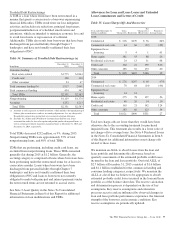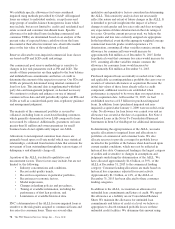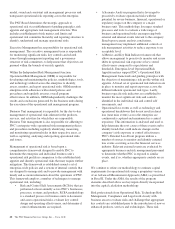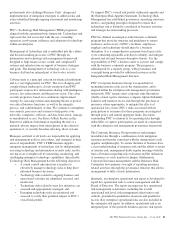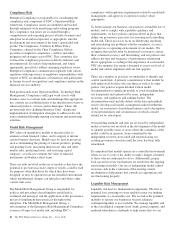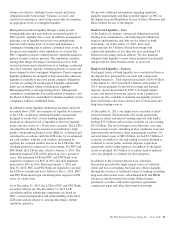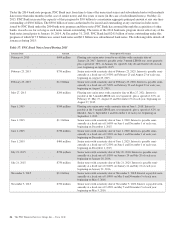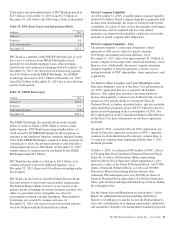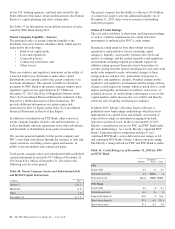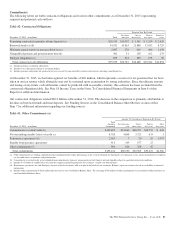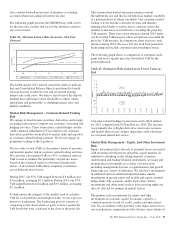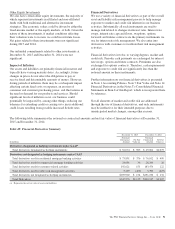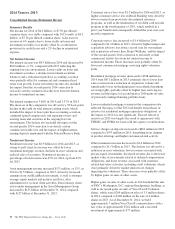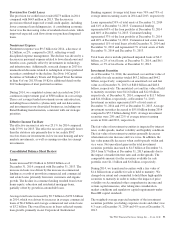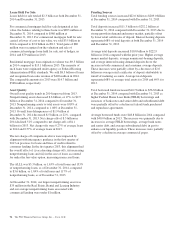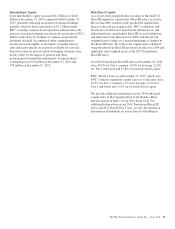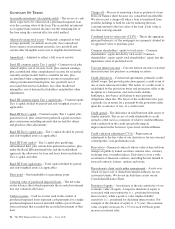PNC Bank 2015 Annual Report Download - page 104
Download and view the complete annual report
Please find page 104 of the 2015 PNC Bank annual report below. You can navigate through the pages in the report by either clicking on the pages listed below, or by using the keyword search tool below to find specific information within the annual report.
by the U.S. banking agencies, and final rules issued by the
Federal Reserve that make certain modifications to the Federal
Reserve’s capital planning and stress testing rules.
See Table 37 for information on an affiliate purchase of notes
issued by PNC Bank during 2015.
Parent Company Liquidity – Sources
The principal source of parent company liquidity is the
dividends it receives from its subsidiary bank, which may be
impacted by the following:
• Bank-level capital needs,
• Laws and regulations,
• Corporate policies,
• Contractual restrictions, and
• Other factors.
There are statutory and regulatory limitations on the ability of
a national bank to pay dividends or make other capital
distributions or to extend credit to the parent company or its
non-bank subsidiaries. The amount available for dividend
payments by PNC Bank to the parent company without prior
regulatory approval was approximately $1.7 billion at
December 31, 2015. See Note 19 Regulatory Matters in the
Notes To Consolidated Financial Statements in Item 8 of this
Report for a further discussion of these limitations. We
provide additional information on certain contractual
restrictions in Note 16 Equity in the Notes To Consolidated
Financial Statements in Item 8 of this Report.
In addition to dividends from PNC Bank, other sources of
parent company liquidity include cash and investments, as
well as dividends and loan repayments from other subsidiaries
and dividends or distributions from equity investments.
We can also generate liquidity for the parent company and
PNC’s non-bank subsidiaries through the issuance of debt and
equity securities, including certain capital instruments, in
public or private markets and commercial paper.
Total parent company senior and subordinated debt and hybrid
capital instruments decreased to $7.5 billion at December 31,
2015 from $10.1 billion at December 31, 2014 due to the
following activity in the period.
Table 40: Parent Company Senior and Subordinated Debt
and Hybrid Capital Instruments
In billions 2015
January 1 $10.1
Maturities (2.5)
Other (.1)
December 31 $ 7.5
The parent company has the ability to offer up to $5.0 billion
of commercial paper to provide additional liquidity. As of
December 31, 2015, there were no issuances outstanding
under this program.
Status of Credit Ratings
The cost and availability of short-term and long-term funding,
as well as collateral requirements for certain derivative
instruments, is influenced by PNC’s credit ratings.
In general, rating agencies base their ratings on many
quantitative and qualitative factors, including capital
adequacy, liquidity, asset quality, business mix, level and
quality of earnings, and the current legislative and regulatory
environment, including implied government support. In
addition, rating agencies themselves have been subject to
scrutiny arising from the most recent financial crisis and could
make or be required to make substantial changes to their
ratings policies and practices, particularly in response to
legislative and regulatory changes. Potential changes in the
legislative and regulatory environment and the timing of those
changes could impact our ratings, which as noted above, could
impact our liquidity and financial condition. A decrease, or
potential decrease, in credit ratings could impact access to the
capital markets and/or increase the cost of debt, and thereby
adversely affect liquidity and financial condition.
In March 2015, Moody’s Investors Service (Moody’s)
published a new bank ratings methodology which has been
implemented on a global basis and includes assessment of
expected loss ratings on instruments ranging from bank
deposits to preferred stock. In the second quarter of 2015,
Moody’s concluded its review for PNC and PNC Bank under
this new methodology. As a result, Moody’s upgraded PNC
Bank’s long-term deposit rating three notches to Aa2,
confirmed PNC Bank’s senior debt and issuer ratings at A2,
and confirmed PNC Bank’s Prime-1 short-term notes rating.
The Moody’s rating outlook for PNC and PNC Bank is stable.
Table 41: Credit Ratings as of December 31, 2015 for PNC
and PNC Bank
Moody’s
Standard &
Poor’s Fitch
PNC
Senior debt A3 A- A+
Subordinated debt A3 BBB+ A
Preferred stock Baa2 BBB- BBB-
PNC Bank
Senior debt A2 A A+
Subordinated debt A3 A- A
Long-term deposits Aa2 A AA-
Short-term deposits P-1 A-1 F1+
Short-term notes P-1 A-1 F1
86 The PNC Financial Services Group, Inc. – Form 10-K



